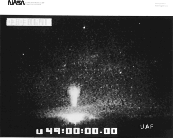 If you have observed a sprite or any other optical emissions above a
thunderstorm, please report it using
this form .
If you have observed a sprite or any other optical emissions above a
thunderstorm, please report it using
this form .
 The NASA Sprite press release (1994 July 26)
The NASA Sprite press release (1994 July 26)
 New:
A NASA press release on observations of Sprites over South America
(1995 June 7)
New:
A NASA press release on observations of Sprites over South America
(1995 June 7)

Slide #1. Black and White Image of Red Sprite
This large red sprite was observed over a thunderstorm in the
Midwest; the top of the sprite is higher than 280,000 feet (85
km); the tendrils beneath the sprite are as low as 195,000 feet
(60 km). The bright area beneath the sprite is an overexposure
of normal lightning occurring at the thunderstorm's cloud top
which is 55,000 feet high. This image was captured on the
night of July 3, at 11:00 PM Central Daylight Time (CDT), using a
low-light-level color television camera from an airplane flying
at 43,000 feet. Universal Time (UT) is shown at the bottom of
the image; 04:00:02:00 UT (on July 4 UT date) equals 11:00:02
CDT.
Image credit: Geophysical Institute, University of Alaska
Fairbanks.

Slide #2. Group of Sprites (with Altitude Marked)
A family of sprites captured over the Midwest on July 6 at 12:29
AM CDT (05:29 UT) using a very wide angle low-light-level, black-
and-white television camera. By using triangulation of the
images of the same sprites taken from the two aircraft, an
accurate determination of the height and size is made. The
thunderstorm's cloud top is at an altitude of about 42,000 feet
and the highest parts of the sprites are at an altitude of 59
miles (95 kilometers). In this image Universal Time is shown in
the upper left; other flight data is shown at the bottom.
Image credit: Geophysical Institute, University of Alaska
Fairbanks.


This large blue jet, shooting upwards from a thunderstorm's top,
reached an upper altitude of about 130,000 feet (40 km). These
jets have been reported in anecdotal accounts over the last
century. This image and other images of jets captured on the
evening of June 30 are the first ever recorded. The jets appear
to move at speeds of 45,000 to 223,000 miles per hour (20 to 100
km per sec). This example was captured with a very wide angle
low-light, black-and-white television camera flying over eastern
Arkansas at 10:03 PM CDT (03:03 UT on UT date July 1). Universal
Time is shown in the upper left; other flight data is shown at
the bottom.
Image credit: Geophysical Institute, University of Alaska
Fairbanks.
To understand more about sprites, how to look for them, current research, and more, click here.
There are some very interesting pictures and accounts of sprites and jets on this page about Shuttle Lightning Observation.